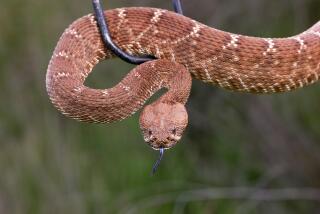Snakebites surge during El Niño’s hot and cold phases, study shows
Climate change might have a nasty bite. A new study on snakebite rates in Costa Rica has found that the bite rate shoots up during El Niño – at both the hot and cold parts of the cycle – and that the problem disproportionately impacts poor, rural populations.
The findings, described in the journal Science Advances, reveals another complexity of the effects of climate change – both the effects it has on animal populations and the way it affects human disease, in the context of socioeconomic disparities.
Climate change isn’t just about warming temperatures and rising sea levels. It also sets in motion complex consequences that may have unforeseen impacts on ecosystems and human health. Research shows that climate change alters patterns of disease transmission. But for this paper, the researchers wanted to focus on another affliction: snakebites.
“Snakebites,” said lead author Luis Fernando Chaves, an ecologist at the Nagasaki University Institute of Tropical Medicine in Japan, “don’t get the attention they deserve, even though they are a major problem.”
After all, snakebites affect 2.5 million people around the world annually, and 400,000 of those people suffer serious medical consequences (such as nerve damage or amputations) and 85,000 of them will die. And because snakes are ectothermic (or “coldblooded”), they rely on the environment to regulate their body temperature, which means their behavior might be highly influenced by the changing weather patterns induced by climate change.
“It can be argued that snakebite envenomation is a neglected tropical disease,” the study authors wrote.
The scientists focused on Costa Rica, which has a universal healthcare system, and where snakebites might be less underreported, partly because reporting snakebites is mandatory. Most snakebites in Costa Rica are chalked up to one particular species of snake, the terciopelo Bothrops asper. And finally, Costa Rica is in just the right spot to experience some serious weather pattern changes thanks to a phenomenon known as the El Niño Southern Oscillation, which is a pattern of fluctuating surface temperature in the tropical eastern Pacific Ocean.
From 2005 through 2013, 6,424 snakebites were reported in Costa Rica. The scientists found that the rate of snakebites surged during the hot phase of El Niño, which is probably because these snakes become more active and might wander farther as it gets warmer, perhaps running into humans in the process.
What was surprising, however, was that the rate of snakebites also shot up around the cold phase of El Niño – which might be because the snakes are having to venture farther out of their comfort zone in search of scarce food.
This snakebite increase seems to disproportionately affect people living in poor, rural areas, Chaves said.
“So this raises the question of, OK, what do you do to decrease the risk of the people that are worse off economically – which kind of politics can the government implement?” Chaves said. “Can it reduce the gap between the rich and the poor?”
In any case, more research needs to be done on the rates of snakebites and their relationship with poverty and climate change, the study authors said.
“Our findings highlight the need for increased research on the ecoepidemiology of snakebites, [a neglected tropical disease] that, as our results robustly suggest, should be included in the list of diseases or health hazards that are sensitive to environmental changes,” the authors wrote.
Follow @aminawrite on Twitter for more science news.
ALSO:
Court revokes approval of insecticide, citing ‘alarming’ decline in bees
Scientists discover new human species relative: Homo naledi
From icky bugs to good grub: Why more people are eating insects







